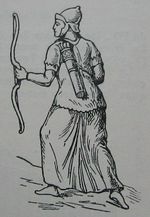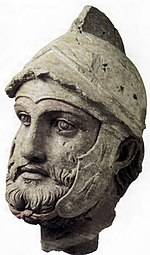Parthia
| Parthia 𐎱𐎼𐎰𐎺 | |
|---|---|
| Historical region of Iran | |
 The region of Parthia within the empire of Medes, c. 600 BC; from a historical atlas illustrated by William Robert Shepherd | |
| Capital | Nisa |
| History | |
• Establishment of the Parthian Empire | 247 BC |
• Fall of the Parthian Empire | 224 AD |
| Today part of | Iran and Turkmenistan |
Parthia (
Name

The name "Parthia" is a continuation from
Parthia was known as
Geography
The original location of Parthia roughly corresponds to a region in northeastern
During Arsacid times, Parthia was united with Hyrcania as one administrative unit, and that region is therefore often (subject to context) considered a part of Parthia proper.[citation needed]
By the early Sasanian period, Parthia was located in the central part of the Iranian plateau, neighboring Pars to the south, Khuzistan to the south-west, Media to the north-west, the Alborz Mountains to the north, Abarshahr to the north-east, and Kirman to the east. In the late Sasanian era, Parthia came to embrace central and north-central Iran but also extended to the western parts of the plateau as well.[1]
In the Islamic era, Parthia was believed to be located in central and western Iran.
History
Under the Achaemenids
As the region inhabited by Parthians, Parthia first appears as a political entity in
A year after
The first indigenous Iranian mention of Parthia is in the
At the Battle of Gaugamela in 331 BC between the forces of Darius III and those of Alexander the Great, one such Parthian unit was commanded by Phrataphernes, who was at the time Achaemenid governor of Parthia. Following the defeat of Darius III, Phrataphernes surrendered his governorate to Alexander when the Macedonian arrived there in the summer of 330 BC. Phrataphernes was reappointed governor by Alexander.[citation needed]
Under the Seleucids
Following the death of Alexander, in the
In 316 BC, Stasander, a vassal of Seleucus I Nicator and governor of Bactria (and, it seems, also of Aria and Margiana) was appointed governor of Parthia. For the next 60 years, various Seleucids would be appointed governors of the province.[citation needed]

In 247 BC, following the death of
Meanwhile, "a man called
A short while later the Parni seized the rest of Parthia from Andragoras, killing him in the process. Although an initial
Under the Arsacids




From their base in Parthia, the
]From about 105 BC onwards, the power and influence of this handful of Parthian noble families was such that they frequently opposed the monarch, and would eventually be a "contributory factor in the downfall" of the dynasty.[16]
From about 130 BC onwards, Parthia suffered numerous incursions by various nomadic tribes, including the
The Roman Crassus attempted to conquer Parthia in 52 BC but was decisively defeated at the Battle of Carrhae. Caesar was planning another invasion when he was assassinated in 44 BC. A long series of Roman-Parthian wars followed.[citation needed]
Around 32 BC, civil war broke out when a certain Tiridates rebelled against
By the 2nd century AD, the
Under the Sasanians
Parthia was likely the first region conquered by Ardashir I after his victory over Artabanus IV, showing the importance of the province to the founder of the Sasanian dynasty.
Parthia continued to hold importance throughout the 3rd century. In his Ka'be-ye Zardusht inscription Shapur I lists the province of Parthia in second place after Pars. The Abnun inscription describes the Roman invasion of 243/44 as an attack on Pars and Parthia. Considering the Romans never went further than Mesopotamia, "Pars and Parthia" may stand for the Sasanian Empire itself.[20] Parthia was also the second province chosen for settlement by Roman prisoners of war after the Battle of Edessa in 260.[1]
Language and literature

The Parthians spoke
In Parthia itself, attested use of written Parthian is limited to the nearly three thousand
The Parthian Arsacids do not seem to have used Parthian until relatively late, and the language first appears on Arsacid coinage during the reign of
The old poems known as fahlaviyat mostly come from the areas which were considered part of Parthia in the Islamic period. These poems have the characteristics of oral literature and may have continued the oral traditions of Parthian minstrels.[1]
Society

City-states of "some considerable size" existed in Parthia as early as the 1st millennium BC, "and not just from the time of the Achaemenids or Seleucids."[26] However, for the most part, society was rural, and dominated by large landholders with large numbers of serfs, slaves, and other indentured labor at their disposal.[26] Communities with free peasants also existed.[citation needed]
By Arsacid times, Parthian society was divided into the four classes (limited to freemen). At the top were the kings and near family members of the king. These were followed by the lesser nobility and the general priesthood, followed by the mercantile class and lower-ranking civil servants, and with farmers and herdsmen at the bottom.[citation needed]
Little is known of the Parthian economy, but agriculture must have played the most important role in it. Significant trade first occurs with the establishment of the
Parthian cities
Nisa (Nissa, Nusay) or Mithradātkert, located on a main trade route, was one of the earliest capitals of the Parthian Empire (c. 250 BC). The city is located in the northern foothills of the Kopetdag mountains, 11 miles west of present-day city of Ashgabat (the capital of Turkmenistan).[27] Nisa had a "soaring two-story hall in the Hellenistic Greek style"[28] and temple complexes used by early Arsaces dynasty. During the reign of Mithridates I of Parthia (c. 171 BC–138 BC) it was renamed Mithradatkirt ("fortress of Mithradates"). Merv (modern-day Mary) was another Parthian city.[citation needed]
- Asaak
- Hecatompylos
- Gurgan
See also
- Pahla
- Parthians
- List of Parthian kings
- Khwarasan
- Greater Khorasan
- Adur Burzen-Mihr
- Parthian shot
References
- ^ ISBN 978-1-78570-210-5, retrieved 2021-02-15
- ^ Lendering, Jona (2001). "Parthia". Livius. Retrieved 11 November 2021.
- S2CID 162332829.
- ^ Diakonoff 1985, p. 127.
- ^ Diakonoff 1985, p. 104,n.1.
- ^ Mallowan 1985, p. 406.
- ^ "Parthia | ancient region, Iran". Encyclopedia Britannica. Archived from the original on 2017-09-20. Retrieved 2017-09-20.
- ^ Cook 1985, p. 248.
- ^ Cook 1985, p. 252.
- ^ Bivar 2003, para. 6.
- ^ a b Curtis 2007, p. 7.
- ^ Lecoq 1987, p. 151.
- ^ a b Bivar 1983, p. 29.
- ^ Bickerman 1983, p. 19.
- ^ Bivar 1983, p. 31.
- ^ a b Schippmann 1987, p. 527.
- ^ Schippmann 1987, p. 528.
- ^ Schippmann 1987, p. 529.
- ^ Lukonin 1983, p. 704.
- )
- ^ Boyce 1983, p. 1151.
- ^ electricpulp.com. "ARMENIA AND IRAN iv. Iranian influences – Encyclopaedia Iranica". www.iranicaonline.org. Archived from the original on 17 November 2017. Retrieved 28 April 2018.
- ^ Boyce 1983, p. 1115.
- ^ Boyce 1983, p. 1157.
- ^ Boyce 1983, p. 1153.
- ^ a b Schippmann 1987, p. 532.
- ^ "Старая и Новая Ниса :: Исторические памятники Туркменистана". www.turkmenistan.orexca.com. Archived from the original on 30 December 2013. Retrieved 28 April 2018.
- ISBN 978-0-691-15773-3.
Bibliography
- Bickerman, Elias J. (1983), "The Seleucid Period", in Yarshater, Ehsan (ed.), Cambridge History of Iran, vol. 3, Cambridge University Press, pp. 3–20.
- Bivar, A.D.H. (1983), "The Political History of Iran under the Arsacids", in Yarshater, Ehsan (ed.), Cambridge History of Iran, vol. 3, Cambridge UP, pp. 21–99.
- Bivar, A.D.H. (2003), "Gorgan v.: Pre-Islamic History", Encyclopaedia Iranica, vol. 11, New York: iranica.com.
- Boyce, Mary (1983), "Parthian writings and literature", in Yarshater, Ehsan (ed.), Cambridge History of Iran, vol. 3, Cambridge UP, pp. 1151–1165.
- Cook, J.M. (1985), "The Rise of the Achaemenids and Establishment of their Empire", in Gershevitch, Ilya (ed.), Cambridge History of Iran, vol. 2, Cambridge University Press, pp. 200–291.
- Diakonoff, I.M. (1985), "Media I: The Medes and their Neighbours", in Gershevitch, Ilya (ed.), Cambridge History of Iran, vol. 2, Cambridge University Press, pp. 36–148.
- Lecoq, Pierre (1987), "Aparna", Encyclopaedia Iranica, vol. 2, New York: Routledge & Kegan Paul, p. 151.
- Lukonin, Vladimir G. (1983), "Political, Social and Administrative Institutions", in Yarshater, Ehsan (ed.), Cambridge History of Iran, vol. 3, Cambridge University Press, pp. 681–747.
- Mallowan, Max (1985), "Cyrus the Great", in Gershevitch, Ilya (ed.), Cambridge History of Iran, vol. 2, Cambridge University Press, pp. 392–419.
- Olbrycht, Marek Jan (1998), Parthia et ulteriores gentes. Die politischen Beziehungen zwischen dem arsakidischen Iran und den Nomaden der eurasischen Steppen, Munich.
- Olbrycht, Marek Jan (2016), "Manpower Resources and Army Organisation in the Arsakid Empire", Ancient Society, 46, pp. 291–338 (DOI: 10.2143/AS.46.0.3167457).
- Schippmann, Klaus (1987), "Arsacids II: The Arsacid Dynasty", Encyclopaedia Iranica, vol. 2, New York: Routledge & Kegan Paul, pp. 525–536.
- Verstandig Andre,(2001) Histoire de l'Empire Parthe. Brussels, Le Cri.
- Wolski, Józef (1993), L’Empire des Arsacides (= Acta Iranica 32), Lovanii: Peeters
- Yarshater, Ehsan (2006), "Iran ii. Iranian History: An Overview", Encyclopaedia Iranica, vol. 13, New York: iranica.com.

